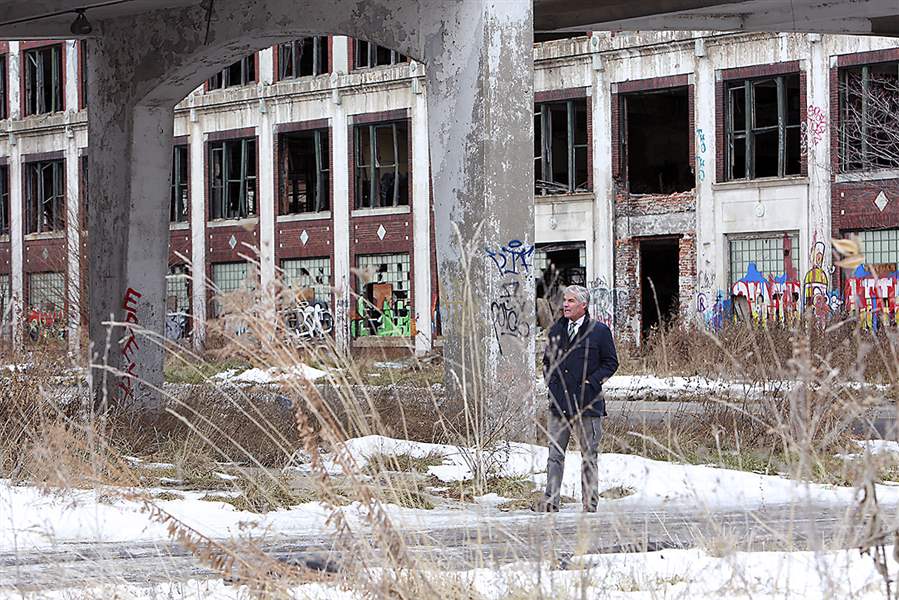
COMMENTARY
Blight City? It depends where you stand
Everything is relative — at least Toledo’s problems are manageable
6/22/2014
A developer from Lima, Peru, tours the abandoned Packard Motors plant in Detroit in this January photo. The long-vacant plant has become an international symbol of urban decay.
NEW YORK TIMES

A developer from Lima, Peru, tours the abandoned Packard Motors plant in Detroit in this January photo. The long-vacant plant has become an international symbol of urban decay.
Just after I moved from Detroit to Toledo a year ago, I spent hours driving around the city. Toledo seemed smaller than it is, more like a city of 150,000. But what really struck me was how good — how solid — the city looked and felt.
No doubt, I saw blight — plenty of it, including the stuff that appeared in The Blade series last week, The Ugly Truth About Toledo. But even on the most blighted blocks and in the poorest neighborhoods — the first spots I visited — most of the houses were standing and occupied.
That’s a far cry from what I saw every day in Detroit, where I lived, happily, for 15 years. With 100,000 vacant residential lots, more than a third of Motown’s 139 square miles are empty. Once a city of nearly 2 million, Detroit has roughly 650,000 people today, while continuing to lose up to 15,000 people a year.
Those numbers don’t begin to reflect the utter devastation on Detroit’s east side, where some neighborhoods are 80 percent empty — vacant, abandoned, burned out. If bombs rained from the sky, they could have hardly done more damage.

Gerritt
The rotting and colossal Packard Motors complex along East Grand Boulevard, a few blocks from where my mother-in-law lived, has become an iconic international symbol of urban decay and the exodus of manufacturing from once dense and humming cities.
Everything is relative. People here worry about public safety. Toledo, with about 35 homicides a year, is one of the safest cities I’ve ever lived in. In Detroit, we considered getting close to 350 homicides a year progress.
I love Detroit. It’s home. And for me, it’s still the greatest city in the country — not only because of its storied history, but also its precarious present and hopeful future.
Despite what you hear, so much good is happening there. Detroiters — tough, resilient, and creative — are the friendliest and most engaging people on the planet. They rise to any challenge.
But you don’t erase problems by ignoring them. I had many conversations with other Detroiters about how to accent the positive without ignoring the serious issues we faced every day. Those same conversations go on in Toledo, and should.
Toledo has the same urban problems as Detroit and any other central city, including blight and population loss. But the problems here are on a much smaller scale. They’re manageable, maybe even reversible, with intelligent, sustained, and concerted action.
The Blade will have performed a public service if it jump-starts that change. Given the shock and awe that followed the paper’s report, I have to wonder whether the shotcallers in this town ever get out of their offices.
The Blade series didn’t expose any hidden reality or unlock any secrets. Many of the buildings portrayed in the report have been there — big as life — for years. Why the surprise and outrage now?
Mayor D. Michael Collins’ response was predictably defensive. We all know there’s a lot more to Toledo than blight. But if there’s a problem, fix it while you still can.
Then there’s the much-quoted former mayor, Carty Finkbeiner, who I’m sure was a fine city chief executive officer. This kind of blight wouldn’t have been tolerated on his watch, he said.
But as with other industrial cities, Toledo’s decline occurred over 60 years, as people and capital fled the central city, a trend accelerated by deliberate state and federal policies. Every Toledo mayor in the past five decades owns a piece of it.
City Councilman Jack Ford, another decent and dedicated guy, came out swinging, calling for the creation of a Blight Authority. That’s fine, but getting jacked up over whether or not the mayor calls the city’s blight problem a crisis won’t help.
Who cares what you call it? We know population loss and blight threaten Toledo’s future. What matters is that people can do something about it here.
Detroit can serve as a cautionary tale, but also a source of inspiration and ideas. Detroiters are proud of their city and determined to bring it back. Toledo could use a little more of that same spirit.
It could also learn from what agencies such as Detroit’s Motor City Blight Busters have done to rebuild hard-knock neighborhoods. Or how mural artist Chaz Miller used public art to spark economic growth in the Artist Village area of northwest Detroit.
A lot of positive things also go on here, as Michael Marsh, president of Toledo Fair Housing Center, noted today in a Readers’ Forum letter. I urge you to read it. He talked about partnerships with the Lucas County Land Bank and the Ability Center of Greater Toledo, as well as neighborhood stabilization projects working with other agencies to alleviate blight — parcel by parcel, block by block — following the foreclosure crisis.
Recognizing the good work that people in Toledo are already doing to fight blight is one way to acknowledge the problem straight-on without leaving people feeling hopeless and powerless.
And there’s no reason for people in this region to feel hopeless or powerless. The blight photos in The Blade could have been taken in any industrial central city in America.
There’s plenty of cause for concern, but no need to panic. From where I stand, Toledo still looks pretty good.
Jeff Gerritt is deputy editorial page editor of The Blade. Contact him at: jgerritt@theblade.com, 419-724-6467, or follow him on Twitter @jeffgerritt.